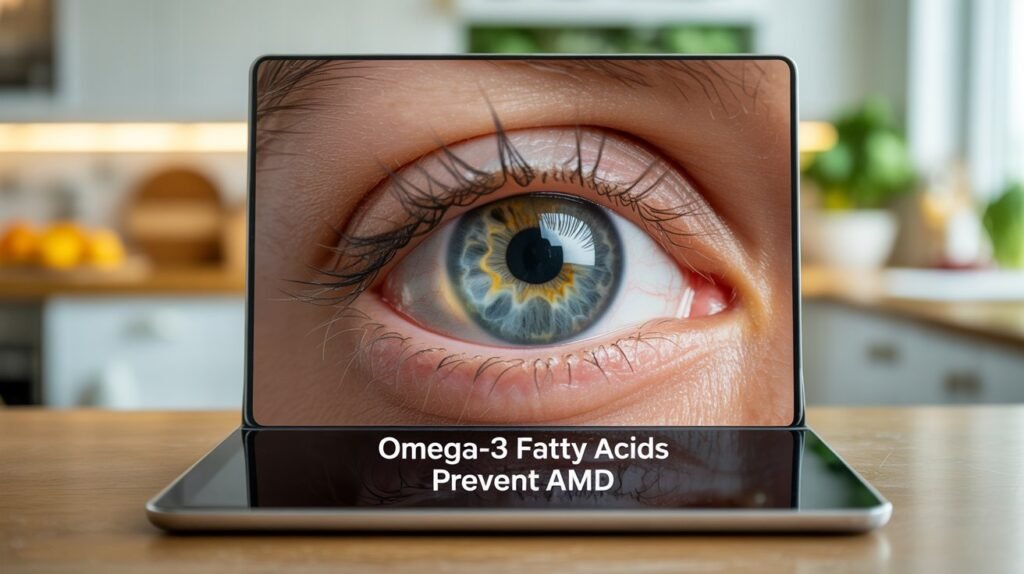Age-related macular degeneration, or AMD, is a painful reality for millions around the world. It’s a condition that slowly steals the sharp, central vision we rely on for reading, driving, and recognizing faces.

Imagine losing the ability to see the details that color your life. That’s why the search for ways to prevent or slow this disease matters so deeply.
One natural approach drawing a lot of attention is the role of Omega-3 fatty acids. But can Omega-3 fatty acids prevent AMD?
Understanding AMD: A Silent Thief of Vision
AMD primarily affects people over 50, with the risk growing as we age. In 2025, about 200 million people worldwide live with some form of AMD.
This number is expected to rise sharply, reaching nearly 288 million by 2040. AMD causes damage to the macula, the small part of the retina responsible for clear central vision. There are two types, dry and wet AMD.
Dry AMD progresses slowly and often shows no early symptoms, whereas wet AMD can cause rapid vision loss and is more severe.
The odds of developing AMD rise significantly with age: only 2% of people aged 50-59 face the advanced form, but by age 75 and older, the risk climbs to nearly 30%.
In the United States alone, around 20 million adults have AMD, and nearly 1.5 million suffer from its late-stage, vision-threatening form. The impact is emotionally and practically devastating, affecting independence and quality of life.
What Are Omega-3 Fatty Acids?
Omega-3 fatty acids are types of healthy fats that play essential roles in the body. Two major kinds found in diets are EPA (eicosapentaenoic acid) and DHA (docosahexaenoic acid).
DHA is especially important for eye health because it is a major structural fat in the retina and brain. Our bodies cannot produce Omega-3 on their own, so getting them through diet or supplements is crucial.
Rich sources of Omega-3 include fatty fish like salmon, mackerel, and sardines, as well as flaxseeds, walnuts, and chia seeds. Today, Omega-3 supplements via fish oil or algal oil are also popular for those who can’t get enough through diet alone. For more options, explore our guide on foods high in omega-3s for stronger vision.
Scientific Evidence Linking Omega-3 and AMD Prevention
Research shows promising signs that Omega-3 fatty acids can help protect the eyes and potentially reduce the risk or slow the progression of AMD.
Several large studies suggest that people who consume more Omega-3 through foods or supplements tend to have lower chances of developing AMD, especially its advanced forms.
One reason for this protective effect is Omega-3’s anti-inflammatory and antioxidant properties. Inflammation and oxidative stress are key factors in the damage seen in AMD.
Omega-3 helps reduce harmful inflammation in retinal tissue, protecting cells from damage.
For example, a well-known study from the Age-Related Eye Disease Study (AREDS2) tested adding Omega-3 to an eye vitamin formula.
While results were mixed, they suggested a trend toward slower progression in AMD for those with higher Omega-3 intake. Other observational studies have found that diets rich in Omega-3s correspond with lower rates of AMD.
While promising, it’s important to note that current evidence is not definitive. Many studies call for further research to confirm how much and what kind of Omega-3 intake is most effective for AMD prevention.
However, the potential benefits and general health advantages of Omega-3 make it a sensible addition to a diet focused on eye health.
How Omega-3 Works to Protect the Eyes
Omega-3 fatty acids influence eye health in several ways:

- Reducing Inflammation: Omega-3s help lower the levels of inflammatory molecules that can damage retinal cells.
- Supporting Cell Structure: DHA is a critical part of the retina’s cell membranes, maintaining their flexibility and function.
- Protecting Against Oxidative Stress: Omega-3s combat oxidative damage caused by free radicals, which can accelerate AMD.
- Improving Blood Flow: TThese fatty acids improve circulation in the eye, supporting the delivery of oxygen and nutrients. Omega-3s also play a big role in eye lubrication – learn how they help with omega-3s for reducing dry eye symptoms.
Together, these actions may protect the macula from early damage and slow the progression of AMD in those already affected.
Dietary Recommendations for Omega-3 to Support Eye Health
To gain the potential benefits of Omega-3 for AMD prevention, experts recommend including rich sources regularly in your diet.
The American Heart Association suggests eating fatty fish at least twice a week, which can provide around 500 milligrams to 1 gram of combined EPA and DHA per day.
For those who don’t eat fish, plant-based sources like flaxseeds and walnuts offer ALA, a precursor to EPA and DHA, but conversion rates are low.
Supplements are a convenient alternative, but should be taken wisely. Many supplements provide between 300 mg and 1,000 mg of EPA and DHA combined per serving.
It’s important not to exceed recommended doses without consulting a healthcare provider, as very high Omega-3 intake can cause side effects like bleeding risk.
Balanced nutrition that combines Omega-3 with other eye-friendly nutrients like vitamins A, C, and E, zinc, and lutein enhances overall protection.
These antioxidants work in synergy to shield retinal cells from damage and support their repair. To dive deeper into how these antioxidants work together, read about the lutein, zeaxanthin, and omega-3 synergy in eye health.
Limitations and Realistic Expectations
While Omega-3 fatty acids offer a hopeful path to reducing AMD risk, they are not a guaranteed cure or complete prevention. Scientific studies so far show mixed results, with some confirming benefits and others showing little effect. This uncertainty means Omega-3 should be seen as part of a broader strategy to protect eye health.
Also, factors like genetics, smoking, high blood pressure, and excessive sun exposure strongly influence AMD risk and can’t be controlled by Omega-3 alone. Managing these lifestyle risks remains crucial.
Overconsuming Omega-3 fatty acids without balancing omega-6 intake in the diet can also disrupt inflammation balance and cause health issues. Therefore, a well-rounded diet, regular eye check-ups, and healthy habits matter just as much as any single nutrient like Omega-3.
Other Steps to Protect Your Vision
To fight AMD and protect vision, consider these proven measures beyond Omega-3:
- Don’t Smoke: Smoking doubles the risk of AMD and worsens progression.
- Protect Your Eyes from UV Rays: Wear sunglasses with UV protection outdoors.
- Eat a Colorful, Balanced Diet: Include leafy greens, fruits, nuts, and whole grains.
- Stay Physically Active: Exercise improves blood flow and reduces disease risk.
- Regular Eye Exams: Early detection helps manage AMD before severe damage occurs.
Natural nutrients like Omega-3 support this healthy foundation, but cannot replace a full lifestyle approach.
Conclusion: Can Omega-3 Fatty Acids Prevent AMD?
In conclusion, Omega-3 fatty acids hold great promise in supporting eye health and may help reduce the risk or slow the progression of age-related macular degeneration.
Their anti-inflammatory and protective roles in retinal cells make them a valuable part of a diet geared toward preserving vision.
However, Omega-3 is not a magic bullet. Combining a diet rich in these healthy fats with other antioxidants, avoiding smoking, and getting regular eye care are essential for stronger protection against AMD.
If you or your family members are concerned about vision health, adding Omega-3-rich foods like fatty fish, flaxseeds, or quality supplements can be a wise and heart-healthy choice. Always discuss any supplement plans with your healthcare provider to ensure safety and the right dosage.
Protecting your vision means taking small but powerful steps each day. Omega-3 fatty acids can be a bright spot on that journey toward clearer sight and a better quality of life.